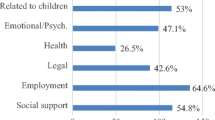Abstract
American Indian women across all ages are significantly more likely than women of other ethnic groups to be victims of domestic violence, sexual assault, and stalking. Despite their increased risk of interpersonal violence, there are few published studies or reports that explicitly examine the needs of victimized American Indian women. Therefore, both researchers and service providers know very little about the multifaceted needs of victimized American Indian women and whether current community services are meeting the needs of victimized native women. Identifying such needs is a logical next step so that victim service agencies can develop and effectively provide services tailored to victimized American Indian women. This commentary addresses these gaps by (1) identifying the needs of American Indian women in a domestic violence shelter in Arizona, and (2) highlighting the researcher-practitioner partnership that made it possible to gain access to these victims. Drawing on survey responses from 37 American Indian female clients and interviews with 10 staff members, the findings reveal that the domestic violence agency service provider is meeting many of their needs. Findings also indicate that clients have a wide variety of specific personal needs (e.g., safety, housing, transportation), needs relating to their children (e.g., safety, education, socialization), community needs (e.g., relating to their tribe), as well as legal needs (e.g., help obtaining a restraining order or divorce). These multifaceted needs are discussed and specific recommendations are provided for successful researcher-practitioner partnerships.
Similar content being viewed by others
References
Barrera, M. (1986). Distinctions between social support concepts, measures, and models. American Journal of Community Psychology, 14, 413–445.
Black, M. C., Basile, K. C., Breiding, M. J., Smith, S. G., Walters, M. L., Merrick, M. T., Chen, J., & Stevens, M. R. (2011). The National Intimate Partner and Sexual Violence Survey (NISVS): 2010 summary report. Atlanta: National Center for Injury Prevention and Control, Centers for Disease Control and Prevention.
Briere, J., & Jordan, C. E. (2004). Violence against women outcome complexity and implications for assessment and treatment. Journal of Interpersonal Violence, 19, 1252–1276.
Campbell, J. (2002). Health consequences of intimate partner violence. Lancet, 359, 1331–1336.
Fisher, B. S., Cullen, F. T., & Turner, M. G. (1999). Extent and nature of the sexual victimization of college women: A national-level analysis. U.S. Department of Justice. Available electronically at https://www.ncjrs.gov/pdffiles1/nij/grants/179977.pdf.
Fox, K. A., Decker, S. H., Fisher, B. S., & Smith, R. (2017). Reducing violence against American Indian women: Strategic plan for page regional domestic violence services, FY 2016–2017. Department of Justice. Office for Victims of Crime. Available electronically at: https://www.researchgate.net/publication/322234682_Reducing_Violence_Against_American_Indian_Women_Strategic_Plan_For_FY_2016-2017.
Macy, R. J., Giattina, M., Sangster, T. H., Crosby, C., & Montijo, N. J. (2009). Domestic violence and sexual assault services: inside the black box. Aggression and Violent Behavior, 14, 359–373.
Navajo Division of Health (2013). Navajo population profile 2010 U.S. Census. Navajo Epidemiology Center. Available electronically at: http://www.nec.navajo-nsn.gov/Portals/0/Reports/NN2010PopulationProfile.pdf.
Sullivan, C. M. (2012). Domestic violence shelter services: A review of the empirical evidence, Harrisburg, PA: National Resource Center on Domestic Violence. Available electronically at: http://www.dvevidenceproject.org/wp-content/themes/DVEProject/files/research/DVShelterResearchSummary10-2012.pdf.
Sullivan, T., Price, C., McPartland, T., Hunter, B. A., & Fisher, B. S. (2016). The researcher–practitioner partnership study (rpps) experiences from criminal justice system collaborations studying. Violence Against Women. https://doi.org/10.1177/1077801216650290.
Taylor, S. E. (2011). “Social support: a review”. In M.S. Friedman. The handbook of health psychology (pp. 189–214). New York: Oxford University Press.
Tjaden, P., & Thoennes, N. (1998). Prevalence, incidence, and consequences of violence against women: Findings from the National Violence Against Women survey. U.S. Department of Justice. Office of Justice Programs. National Institute of Justice. Centers for Disease Control and Prevention.
Tolman, R. M., & Raphael, J. (2000). A review of research on welfare and domestic violence. Journal of Social Issues, 56, 655–682.
U.S. Census Bureau (2010). ASC dataset 2006–2010.
Warshaw, C., Sullivan, C. M., & Rivera, E. A. (2013). A systematic review of trauma-focused interventions for domestic violence survivors. National Center on Domestic Violence, Trauma & Mental Health. Available electronically at: https://vaw.msu.edu/wp-content/uploads/2013/10/NCDVTMH_EBPLitReview2013.pdf.
Acknowledgements
This project was produced by the authors under 2015-VF-GX-K016, awarded by the Office for Victims of Crime, Office of Justice Programs, U.S. Department of Justice. The opinions, findings, and conclusions or recommendations expressed in this report are those of the contributors and do not necessarily represent the official position or policies of the U.S. Department of Justice. We especially wish to thank Page Regional Domestic Violence Services’ Executive Director, Gregg Martinez, who embraces agency growth, actively mobilizes the staff and clients, and embodies the organization’s mission to serve. We thank the staff and clients who participated in this research by offering their valuable insight into the lives of domestic violence survivors. We acknowledge the assistance of those who helped pilot and provided instrumental feedback on the client survey including: Ann Brandon of the Ohio Alliance to End Sexual Violence, Nancy Grigsby of the Ohio Domestic Violence Network, and Nicole Wilkes of the University of Cincinnati, School of Criminal Justice. We also thank Rachael Smith, Kayleigh Stanek, and Diana Caraveo Parra for their research assistance. Finally, we acknowledge Arizona State University for research assistant funding under the Anne Larason Schneider Faculty Endowment for Community Research award and the ASU Foundation.
Author information
Authors and Affiliations
Corresponding author
Rights and permissions
About this article
Cite this article
Fox, K.A., Fisher, B.S. & Decker, S.H. Identifying the Needs of American Indian Women Who Sought Shelter: A Practitioner-Researcher Partnership. J Fam Viol 33, 251–256 (2018). https://doi.org/10.1007/s10896-018-9953-8
Published:
Issue Date:
DOI: https://doi.org/10.1007/s10896-018-9953-8




